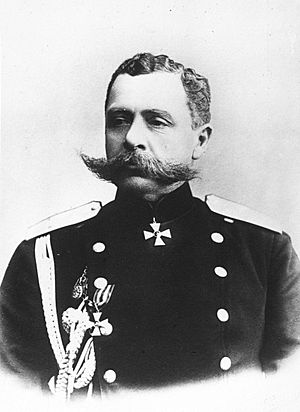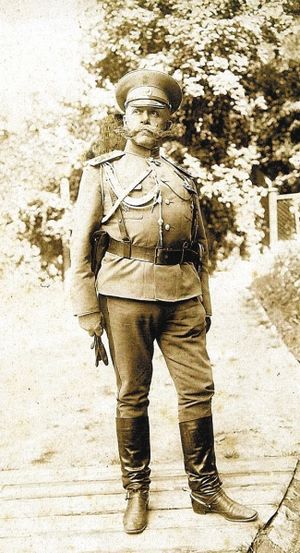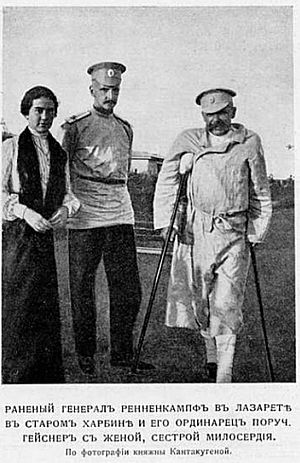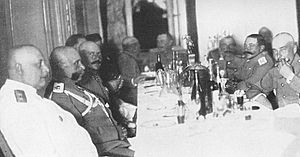Paul von Rennenkampf facts for kids
Quick facts for kids
Edler
Paul von Rennenkampf
|
|
|---|---|

Rennenkampf in 1910
|
|
| Commander of the Vilna Military District | |
| In office 20 January [O.S. 7] 1913 – 19 July [O.S. 6] 1914 |
|
| Monarch | Nicholas II |
| Preceded by | Fyodor Martson |
| Succeeded by | Position abolished |
| Personal details | |
| Born | 29 April [O.S. 17] 1854 Konofer Manor, Konofer, Kreis Hapsal, Governorate of Estonia, Russian Empire (in present-day Konuvere, Rapla County, Estonia) |
| Died | 1 April 1918 (aged 63) Taganrog, Russian SFSR |
| Resting place | Taganrog Old Cemetery |
| Nationality | Baltic German |
| Military service | |
| Allegiance | |
| Branch/service | |
| Years of service | 1870–1915 |
| Rank | |
| Commands | 36th Akhtyrka Dragoon Regiment 1st Separate Cavalry Brigade Transbaikal Cossack Army 7th Siberian Army Corps 3rd Siberian Army Corps 3rd Army Corps Vilna Military District (1913–1914) 1st Army |
| Battles/wars | Boxer Rebellion
|
Paul Georg Edler von Rennenkampf was a famous general in the Imperial Russian Army. He was born on April 29, 1854, in what is now Estonia. He was known for leading the 1st Army during the early part of World War I.
Rennenkampf was a skilled cavalry commander. He gained a strong reputation during the Boxer Rebellion in China and the Russo-Japanese War. After these wars, he helped stop a rebellion during the 1905 Russian Revolution. This led to him being promoted many times.
By the time World War I started, Rennenkampf was in charge of the Vilna Military District. His troops from this district became the 1st Army under his command. He led them into East Prussia and won an early battle at Gumbinnen. However, he was later removed from his command after some difficult defeats.
Paul von Rennenkampf was sadly shot by the Bolsheviks in 1918 during a time of great unrest in Russia.
Contents
Early Life and Family
Paul Georg Edler von Rennenkampf was born on April 29, 1854. His family lived in the Konofer manor, which is now in Estonia. He was one of eight children. His family, the Rennenkampffs, were part of the Baltic German nobility. This means they were German families who lived in the Baltic countries.
His family had a long history. His ancestors came from Germany. On his mother's side, he was related to the Stackelberg family. One of his relatives was also a general in the Russo-Japanese War.
Military Career
Rennenkampf's military career began in the late 1800s. He worked in different military districts, like the Warsaw Military District. He also became the chief of staff for the Osowiec Fortress in Russian Poland. By 1899, he was promoted to major general.
Fighting in China
From 1900 to 1901, Rennenkampf took part in the Boxer Rebellion in China. This was a conflict where Chinese people rebelled against foreign influence. He was very successful during this campaign. He received two high awards for his bravery and skill.

Russo-Japanese War
In February 1904, the Russo-Japanese War began. Rennenkampf was put in charge of the Trans-Baikal Cossack Division. He was promoted to lieutenant-general in June for his excellent military work.
During the Battle of Mukden, Rennenkampf showed great determination. He commanded a group of soldiers on the left side of the Russian army. His strong defense helped stop the Japanese attack. After this war, he commanded several different army groups.
In 1910, he became a General of the Cavalry. This was a very high rank. In 1913, he was made commander-in-chief of all troops in the Vilna Military District.
World War I
When World War I started, Rennenkampf was given command of the 1st Army. This army was part of the Northwestern Front.

Early Battles in East Prussia
On August 7, 1914, Rennenkampf and his troops entered East Prussia. This started the Eastern Front of the war. The German army tried to counterattack at the Battle of Stallupönen. However, Russian artillery stopped their advance.
Rennenkampf continued to move forward. He defeated the German 8th Army at the Battle of Gumbinnen. But this victory did not lead to further success because of mistakes made by his commander.
Tannenberg and Masurian Lakes
After Gumbinnen, Rennenkampf was ordered to attack Königsberg. However, his army did not connect with another Russian army, the 2nd Army. This was due to a mistake by their overall commander. The German army used this gap to surround and almost destroy the 2nd Army at the Battle of Tannenberg.
The commander of the 2nd Army asked Rennenkampf for help. But Rennenkampf was slow to respond. This delay contributed to the defeat of the 2nd Army. After the battle, the 2nd Army's commander sadly took his own life.
After this defeat, Rennenkampf's army had to defend a large area. On September 7, the First Battle of the Masurian Lakes began. The Germans attacked his army's left side. Rennenkampf did his best to move his troops and avoid being surrounded. By September 15, he skillfully pulled his men back, saving the remaining soldiers.
Battle of Łódź and Dismissal
In November, during the Battle of Łódź, the 1st Army could not stop a German group from escaping. This caused the Russian front line to retreat. After this, Rennenkampf was removed from his command.
His actions during the battle were investigated. He was even thought to be a traitor because of his German background. However, he was later found innocent for the mistakes made at Łódź. He was officially dismissed from the army in October 1915.
After his dismissal, he lived in Petrograd with his wife. However, his retirement was difficult. People often insulted him, falsely accusing him of being a traitor.
October Revolution and Death
After the October Revolution in 1917, Rennenkampf was arrested. He was held in the Peter and Paul Fortress. He was later released because his health was getting worse.
He then went south to Taganrog, his wife's hometown. He tried to hide his identity. But the Red Army found him. He was offered a command in the Red Army, but he refused. He famously said:
I'm old. I have not much left to live, for the salvation of my life, I will not become a traitor and will not go against my own. Give me a well-armed army, and I will go against the Germans, but you have no army; to lead this army would mean leading people to slaughter, I will not take this responsibility on myself.
Because he refused, Rennenkampf was taken hostage by the Bolsheviks. He was executed near the railway tracks on April 1, 1918.
Rennenkampf was buried in an unmarked mass grave with other victims. Years later, photos were found that showed a marked grave with his name on it. This helped historians find his final resting place in the Old Cemetery in Taganrog.
Family Life
Rennenkampf was married four times. He had children from his first two marriages. His last marriage was to Vera Nikolayevna Krassan in 1907. They had a daughter named Tatyana. He also adopted Vera's daughter, Olga.
His marriage to Vera was a happy one. Vera was very active in helping others. She worked with the International Red Cross and Red Crescent Movement. During the war, she helped care for wounded soldiers. She also helped families of soldiers and organized workshops to make things for the front lines.
After Rennenkampf's death, his wife Vera and daughter Tatyana managed to escape to Paris, France.
Images for kids
See also
 In Spanish: Paul von Rennenkampf para niños
In Spanish: Paul von Rennenkampf para niños




